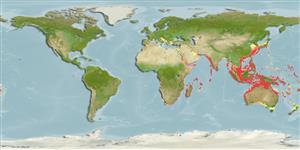Common names from other countries
Environment: milieu / climate zone / depth range / distribution range
Ecologia
; intervalo de profundidade 0 - 165 m (Ref. 107300). Tropical
Indo-Pacific, Southeast Atlantic and the Mediterranean.
Length at first maturity / Tamanho / Peso / Idade
Maturity: Lm ? range ? - ? cm Max length : 5.0 cm TL macho/indeterminado; (Ref. 844)
Assumed maximum length from Ref. 844. A strictly herbivorous species that is common on rocky reefs (Ref. 844), and always found around soft silt or mud in where it is usually buried (Ref. 866) during the day (Ref. 107294); common in deep rock pools and tidal swimming pools (Ref. 866). Nocturnal. Emerges at night to feed on seaweeds and grasses (Ref. 107294).
Life cycle and mating behavior
Maturidade | Reprodução | Desova | Ovos | Fecundidade | Larvas
Members of the order Cephalaspidea are mostly simultaneous hermaphrodites.
Debelius, H. 2001. (Ref. 844)
Status na Lista Vermelha da IUCN (Ref. 130435)
Status no CITES (Ref. 108899)
Not Evaluated
Not Evaluated
Uso pelos humanos
| FishSource |
Ferramentas
Mais informação
Idade/TamanhoCrescimentoComprimento-pesoComprimento-comprimentoMorfologiaLarvasAbundância
Fontes da internet
Estimates based on models
Preferred temperature
(Ref.
115969): 23.7 - 29, mean 27.5 (based on 986 cells).
Vulnerabilidade
Low vulnerability (10 of 100).
Categoria de preço
Unknown.
